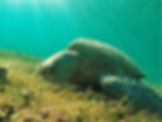Patrolling key Green sea turtle nesting sites in Kalimantan
Conservation focus:
Green sea turtle
Scientific name:
Chelonia mydas
Scientific classification:
Reptiles, Testudines, Cheloniidae
IUCN status:
EDGE status:
EN (endangered)
Score 11.1, Rank 52 / 103 EDGE testudines
Threatened evolutionary history:
18 million years
Conservation priority by EDGE rank / ecosystem



Why it matters
Green sea turtles are nomads of the seas, making them hard to protect. They live in the coastal areas of more than 140 countries, nesting in over 80 countries with tropical and subtropical coasts. Northern Borneo hosts some key nesting sites of the East Indian / West Pacific population. Some tiny islands of East Kalimantan are critical for the species' survival in this area. That's why we enable ranger patrols to deter illegal and harmful activities threatening these beaches, especially. Coastal development, disturbance from beachfront activities and lighting, shoreline armouring and rising seas have led to the degradation or loss of much nesting beach habitat. Moreover, poaching of eggs and turtles, bycatch in fishing gear, vessel strikes and pollution have caused a global population decline in this old, unique species.
Project fast facts
Focal species' population trend
Decreasing globally and locally
Local conservation attention
Low to high, depending on nesting site location
Range / Project area

Ecological role
The green sea turtle plays a crucial ecological role in maintaining marine ecosystem balance. By grazing on seagrass, it prevents overgrowth and supports healthy seagrass beds, which in turn sustain biodiversity, enhance nutrient cycling, and provide habitat for various marine species. Its presence also serves as an indicator of coastal ecosystem health and sustainability.
Threats
The green sea turtle (Chelonia mydas) and its nesting habitats face significant threats that endanger both the species and the broader coastal ecosystem. In East Kalimantan, one of the most pressing threats is the illegal collection of eggs for consumption or trade, which directly reduces hatchling survival. Moreover, coastal development and human infrastructure disrupt nesting beaches, while artificial lighting disorients hatchlings during their journey to the sea. In the ocean, green turtles are frequently caught as bycatch in fishing gear or become entangled in marine debris such as plastic waste. Ingested plastics can lead to internal injuries or starvation. Climate change also poses a growing risk, as rising temperatures affect sand incubation, skewing sex ratios and reducing hatch success. Additionally, unregulated tourism activities can trample nests and stress adult turtles. Combined, these threats create a complex challenge that demands targeted and sustained conservation efforts to protect both the species and its nests.
Grant
First awarded:
$ 10'000
29 May 2025
Score 11.1, Rank 52 / 103 EDGE testudines
Programme owner
Conservation Action Network (Jaringan Aksi Konservasi)
Programme contact
Paulinus Kristianto
Project location
Indonesia, East Kalimantan
Pulau Sangalaki, East Kalimantan, Indonesia


Addressing the need: Project goals
Improve reproductive success and survival of green sea turtles in northeast Kalimantan (Borneo, Indonesia).
This conservation initiative focuses on protecting green sea turtle (Chelonia mydas) nesting beaches in Sangalaki and Derawan, East Kalimantan. The project aims to reduce illegal egg collection, strengthen ranger patrols, and improve community awareness. Trained community rangers will patrol nesting sites 24/7 during the peak season to prevent poaching and monitor nest activity. Each ranger will be equipped with essential tools such as flashlights, uniforms, logbooks, and GPS. Public outreach will also be carried out through awareness campaigns in schools and tourist areas. Informational signs will be installed to minimize human disturbance. The project works in collaboration with local authorities to ensure law enforcement is supported. All activities will be reported and monitored to evaluate impact and improve long-term protection efforts. This action plan combines direct field protection with local participation to secure the future of turtle populations in the Derawan seascape.
Conservation actions
We expect a reduction in illegal egg collection and increased hatchling survival through consistent beach patrols by trained community rangers. The project will improve nest monitoring, enable data collection, and restore protection at key nesting beaches. Local awareness campaigns will strengthen public support and reduce human disturbance. In the long term, we aim to enhance the survival of Chelonia mydas in the region by protecting critical nesting sites, building community ownership, and improving coordination with local authorities.




